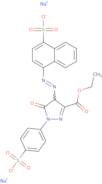Informations sur le produit
- 1H-Pyrazole-3-carboxylic acid, 4,5-dihydro-5-oxo-4-[(4-sulfo-1-naphthalenyl)azo]-1-(4-sulfophenyl)-, 3-ethyl ester, disodium salt
- 1H-Pyrazole-3-carboxylic acid, 4,5-dihydro-5-oxo-4-[2-(4-sulfo-1-naphthalenyl)diazenyl]-1-(4-sulfophenyl)-, 3-ethyl ester, sodium salt (1:2)
- 2-Pyrazoline-3-carboxylic acid, 5-oxo-4-[(4-sulfo-1-naphthyl)azo]-1-(p-sulfophenyl)-, 3-ethyl ester, disodium salt
- Orange B
- disodium 4-[[3-ethoxycarbonyl-5-oxo-1-(4-sulfonatophenyl)-4H-pyrazol-4-yl]azo]naphthalene-1-sulfonate
- disodium 4-{2-[3-(ethoxycarbonyl)-5-oxo-1-(4-sulfonatophenyl)-1,5-dihydro-4H-pyrazol-4-ylidene]hydrazino}naphthalene-1-sulfonate
Orange 137 is a peroxidase that has been used in the detection of sweet substances. It catalyzes the oxidation of coniferyl alcohol to give an aldehyde and hydrogen peroxide. The reaction is sensitive to pH, with optimum activity at pH 8.5. Orange 137 can also be used as a model system for other enzymes, such as polymeric lignins and hydrophilic polymers, because it demonstrates their basic properties. Orange 137 is synthesized by polymerizing synthetic lignins or cross-linking natural lignins extracted from leaves.





